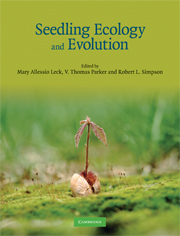Book contents
- Frontmatter
- Contents
- Contributors
- Foreword by Peter J. Grubb
- Preface
- Acknowledgments
- Part I Introduction
- Part II Seedling diversity
- Part III Seedling morphology, evolution, and physiology
- Chapter 5 Embryo morphology and seedling evolution
- Chapter 6 Regeneration ecology of early angiosperm seeds and seedlings: integrating inferences from extant basal lineages and fossils
- Chapter 7 Physiological and morphological changes during early seedling growth: roles of phytohormones
- Chapter 8 Seedling ecophysiology: strategies toward achievement of positive net carbon balance
- Chapter 9 The role of symbioses in seedling establishment and survival
- Part IV Life history implications
- Part V Applications
- Part VI Synthesis
- References
- Index
Chapter 6 - Regeneration ecology of early angiosperm seeds and seedlings: integrating inferences from extant basal lineages and fossils
Published online by Cambridge University Press: 05 June 2012
- Frontmatter
- Contents
- Contributors
- Foreword by Peter J. Grubb
- Preface
- Acknowledgments
- Part I Introduction
- Part II Seedling diversity
- Part III Seedling morphology, evolution, and physiology
- Chapter 5 Embryo morphology and seedling evolution
- Chapter 6 Regeneration ecology of early angiosperm seeds and seedlings: integrating inferences from extant basal lineages and fossils
- Chapter 7 Physiological and morphological changes during early seedling growth: roles of phytohormones
- Chapter 8 Seedling ecophysiology: strategies toward achievement of positive net carbon balance
- Chapter 9 The role of symbioses in seedling establishment and survival
- Part IV Life history implications
- Part V Applications
- Part VI Synthesis
- References
- Index
Summary
Introduction
Flowering plants – angiosperms – are presently the most ecologically significant lineage on the green-plant tree of life. With the exception of high latitude and some upland regions, angiosperms dominate both the species number and biomass of the world's major biomes. Furthermore, the chemistry, productivity, and structure of angiosperms are the foundation of ecological webs of biotic interactions that generate and sustain terrestrial biodiversity.
Yet, despite their entrenched and manifold roles in today's ecosystems, angiosperms represent the youngest major group of terrestrial plants (Wing & Boucher, 1998; Boyce, 2005). Compared to other major lineages of plant evolution that appear in the fossil record during the mid-to late Paleozoic, angiosperms are relative newcomers with the first undisputed fossils appearing nearly 100 Ma later during the Early Cretaceous. This pattern raises the question: How did angiosperms achieve such tremendous diversity and nearly singular ecological dominance over a relatively brief geological interval (≈100–60 million years ago; Wing & Boucher, 1998; Lupia et al., 1999; Nagalingum et al., 2002)? Answering this question is difficult because the deep time phases of angiosperm evolution, preeminently their early biology and causes of initial success, remain uncertain (Wing & Boucher, 1998). Ultimately, the early angiosperm enigma clouds the resolution of the biological and environmental mechanisms sparking the rise of the modern day angiosperm epoch and diverse biotas that co-evolved with them.
- Type
- Chapter
- Information
- Seedling Ecology and Evolution , pp. 130 - 149Publisher: Cambridge University PressPrint publication year: 2008
- 2
- Cited by



